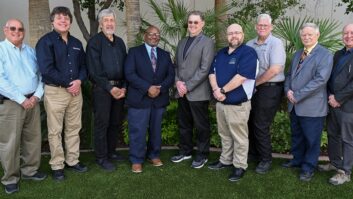WASHINGTON — Opinions vary in radio circles on whether the Federal Communications Commission should move forward with a proposal to allow some Class A FMs to upgrade power levels from 6,000 to 12,000 Watts.
Some think the timing for the power boost is bad, following the rapid proliferation of FM translators and low-power FM stations in this country.

Crank up the power? Supporters see the proposal as a chance to benefit small-town FMs in several ways.
credit: iStockphoto/anigoweb
Others see it as a chance for hundreds of small-town FMs to double their effective radiated power, expand listening areas and tap into additional advertising revenue.
The idea of creating such an FM class has been bruited before. But Commissioner Ajit Pai sparked hopes at the 2016 Radio Show in Nashville when he said he’s pushing for the commission to issue a notice of proposed rulemaking. His comments drew a lot of industry attention.
Proposed Class C4 FM stations would be allowed a maximum effective radiated power level of 12 kW from a reference antenna height of 100 meters above average terrain.
“An NPRM would allow us to ask the right questions, explore the advantages and disadvantages of the proposal and receive the review of all stakeholders. Then we would be in a better position to determine whether to implement this idea,” Pai said at the Radio Show.
Observers say the commission could adopt either a notice of inquiry or a NPRM, the latter formally proposing a change in its rules. FCC officials declined comment for this story about the proposal and whether further consideration is imminent.
RM-11727
Matthew Wesolowski, licensee of WYAB(FM) in Flora, Miss., and David Honig from the Multicultural Media, Telecom and Internet Council, are co-petitioners of the FM Class C4 proposal. In 2014 the commission took preliminary comments on their rulemaking request and assigned it a rulemaking number (RM-11727).
Wesolowski and Honig say there are many owners of small Class A FM “mom and pop” operations that are sometimes “just barely paying the bills.” They estimated there are 800 Class A FM stations in mostly rural areas that could take advantage of the upgrade.
Wesolowski says hundreds of small-town stations across the country faced with uneven terrain and electronic interference issues would benefit from improved indoor reception.
The petition specifically calls for the Class C4 allocation to be assigned to facilities in Zone II of the United States, generally rural areas — and thus limiting potential negative impact on FM translators.
Wesolowski maintains that respondents to the FCC’s preliminary request in 2014 “were almost universally positive.”
Opponents of the creation of a Class C4 point to an already crowded FM band and suggest the upgrade could cause harm to existing translators.
The sheer numbers of FM translators has grown dramatically over the years; the commission currently lists nearly 7,000. Interest in them increased further when the FCC began allowing AM licensees to retransmit their signals on FM translators. FM translators also have become a popular option for retransmitting HD2 signals. This landscape complicates matters, some experts say.
WAIT AND SEE
Broadcast engineering consultant Charles Anderson, president of Anderson Associates, said the C4 proposal represents another logical step in achieving efficient use of the FM spectrum.
“Its utility will be primarily for stations that are on the edge of achieving good coverage of their cities of license and significant populations centers within their existing coverage areas. Improved building penetration and overcoming unfavorable terrain will be the main benefits,” he said.
However, Anderson believes any final rulemaking should be delayed until after the next filing windows for AM owners to apply for FM translators; those are expected in 2017 though not yet formally scheduled. This would help minimize the impact, he said.
“Furthermore, any C4 upgrade should be conditioned on any displaced fill-in translator being able to move to any other available channel in the band or being modified to retain at least 75 percent of its current coverage area,” Anderson said.
It is also possible that some Class A stations upgraded to C4 might not be able to take advantage because of economic reasons.
One broadcast engineer said he “doubts there will be a significant number of stations which can obtain a significant power increase without relocating their transmitter sites,” another cost consideration.
Mark Lipp, a partner at Wiley Rein, said he is not sure what the interest level will be among Class A broadcasters presented with an opportunity to upgrade power levels.
“The FCC staff and engineers will be able to determine how many can increase, but it isn’t known whether those stations would actually take advantage of the opportunity,” Lipp said, “though that number might not be that significant.”
Lipp said the concern about interference among FM translator users is legitimate.
Owners of those FM translators are left “not knowing whether there will be a Class C4 and whether they could be displaced by the Class C4 increase. The FCC cannot protect these translators,” Lipp said. “Translator applicants should at least know what the spectrum constraints are when they apply. But these translators cannot be protected without offering the same protection to all other existing translators and to LPFM stations.”
LPFM IMPLICATIONS
It’s also possible the C4 Class could adversely affect some of the more than 1,600 low-power FMs.
“There are LPFM facilities that are likely to experience some additional degraded services, especially on the fringe area of their service contours, if a Class A station is permitted to upgrade to Class C4,” REC Networks’ Michi Eyre wrote to the FCC in filed comments.
The consultancy says it has identified a number of LPFM licensees that could be affected by development of a Class C4. Low-power FM stations, which broadcast at a maximum of 100 Watts, typically reach a radius of seven to 10 miles from the antenna.
Another observer said creation of Class C4 would likely increase noise and congestion in the FM band.
“Resistance [to the proposal] arises when one looks at the impact the power increases might have,” said Melodie Virtue, a communications attorney at Garvey Schubert Barer who specializes in FCC filings and applications. She said it could limit flexibility for site moves for stations that get hemmed in and reduce listenership outside predicted contours that stations not eligible for a power increase currently enjoy.
John Garziglia, a communications attorney with Womble Carlyle Sandridge & Rice, said the petition is a bad idea in today’s world of broadcasting.
“While another new intermediate FM class might have been a good idea a decade ago, such a change now in the FM rules has the potential to displace many FM translators currently carrying AM signals and HD2 signals,” he said.
Garziglia recalls the first time some Class A broadcasters were given the opportunity to double power levels from 3,000 to 6,000 Watts decades ago.
“Was the slight increase in coverage nice for FM stations? Yes. But did the power increase make a substantial difference in either listenership or fortunes of Class A stations? Rarely,” he said.
Jack Sellmeyer, president of Sellmeyer Engineering, anticipates the FCC will consider the proposal further, though the change in presidential administrations and the naming of a new FCC chairman could play a role in the timing.
“I don’t think there are any significant obstacles to a notice of proposed rulemaking other than the staff time required to prepare it for a vote and issuance. I suspect there is a draft circulating among the commissioners. As to when and if they will act, that is anyone’s guess. There is not enough time to complete it before the new administration takes office,” Sellmeyer said.
Comment on this or any story. Email[email protected] with “Letter to the Editor” in the subject field.












